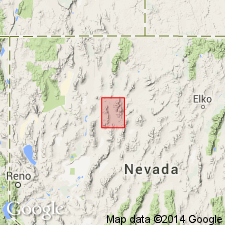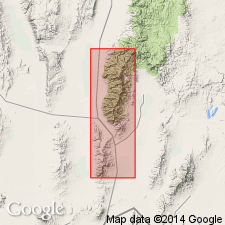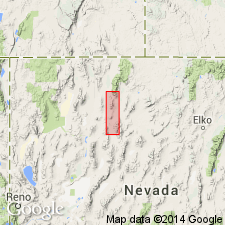
- Usage in publication:
-
- Winnemucca formation*
- Modifications:
-
- Original reference
- Dominant lithology:
-
- Shale
- Sandstone
- AAPG geologic province:
-
- Great Basin province
Summary:
See also S.W. Muller and others, 1951, Geol. Mount Tobin quadrangle, NV, USGS Geol. Quad Map GQ-7, 1 sheet, scale 1:125,000.
Winnemucca formation. Consists of shales and sandstones interbedded with dolomites and limestones. In Sonoma Range, lower part is shale or slate with numerous limestones and dolomite beds; sandstone prominent near top. In East Range, slate and quartzite, some limestone in upper part. Basal contact drawn at lowest prominent clastic bed. Thickness at type locality about 2,000 feet. In East Range, about 3,000 feet thick. Overlies Dun Glen formation (new) with local unconformity. Age is Late Triassic.
Type locality: Mullen Canyon, west side of Sonoma Range, 8 mi south of Winnemucca, Winnemucca quadrangle (scale 1:100,000), north central NV.
Source: US geologic names lexicon (USGS Bull. 1200, p. 4263-4264); GNU records (USGS DDS-6; Menlo GNULEX).

- Usage in publication:
-
- Winnemucca formation*
- Modifications:
-
- Areal extent
- AAPG geologic province:
-
- Great Basin province
Summary:
Pg. 1387, pl. 1 (geol. map). Winnemucca formation. Calcareous slate and calcareous phyllite are principal and most distinctive rocks. Thickness 600 to 1,500 feet. In Santa Rosa Range, overlies Grass Valley formation and conformably underlies O'Neill formation (new). No persistent unit as calcareous as the Dun Glen formation occurs in Santa Rosa Range, but local thick lenses of limestone and dolomite indicate that the Winnemucca formation of Santa Rosa Range may connect laterally with both Winnemucca and Dun Glen formations of Winnemucca quadrangle (scale 1:100,000), north-central Nevada. Poorly preserved, distorted ammonites of probable early Late Triassic (Karnian) age were collected from near top of formation and 200 feet above base. Age is considered Late Triassic.
Mapped in southeast and northwest parts of Santa Rosa Range, north-central NV, [north of Winnemucca quadrangle (scale 1:100,000) of Muller and others, 1950].
Source: Publication; US geologic names lexicon (USGS Bull. 1200, p. 4263-4264); GNU records (USGS DDS-6; Menlo GNULEX).

- Usage in publication:
-
- Winnemucca Formation*
- Modifications:
-
- Revised
- AAPG geologic province:
-
- Great Basin province
Summary:
Included as second oldest formation in south Santa Rosa Range of Auld Lang Syne Group (new). Type locality of Muller and others (1951) redesignated as secs.4-5 T34N R38E, Winnemucca 15' quad, Pershing Co, NV. Occurs in south Santa Rosa Range, Krum Hills, north Santa Rosa Range, south Humboldt Range, north Stillwater Range, and south Tobin Range. Age remains Late Triassic (Norian).
Source: GNU records (USGS DDS-6; Menlo GNULEX).
For more information, please contact Nancy Stamm, Geologic Names Committee Secretary.
Asterisk (*) indicates published by U.S. Geological Survey authors.
"No current usage" (†) implies that a name has been abandoned or has fallen into disuse. Former usage and, if known, replacement name given in parentheses ( ).
Slash (/) indicates name conflicts with nomenclatural guidelines (CSN, 1933; ACSN, 1961, 1970; NACSN, 1983, 2005, 2021). May be explained within brackets ([ ]).

